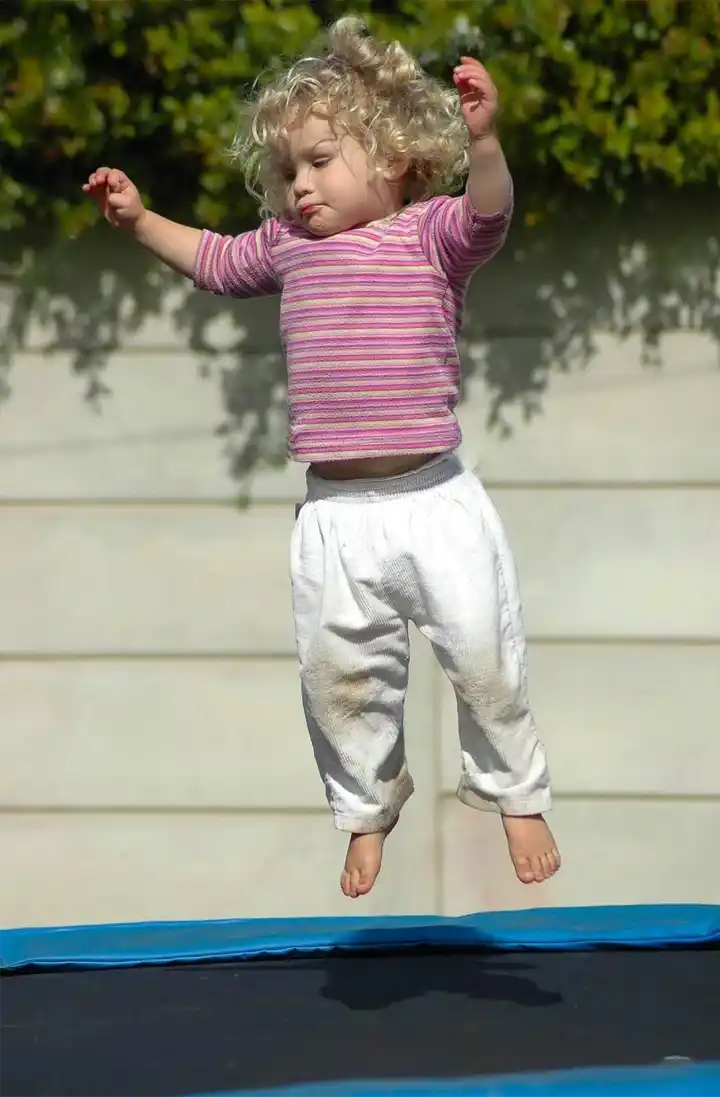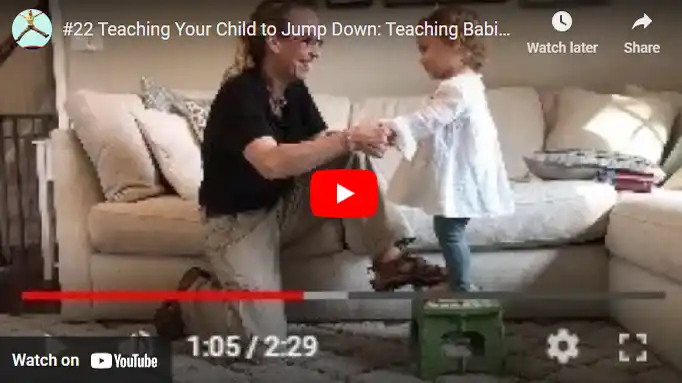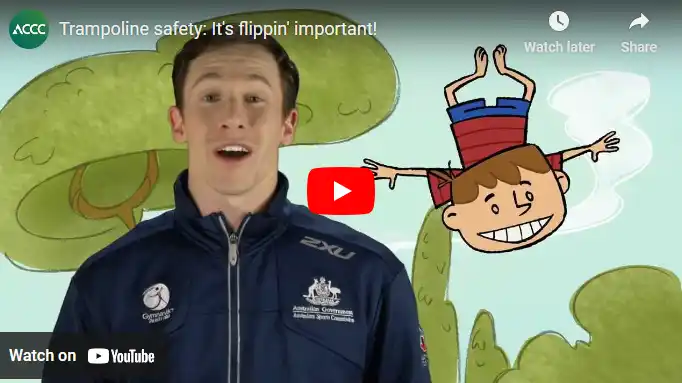What Is the Mini Trampoline Age Range for Kids?
Disclaimer: This website exists thanks to you, the readers. When you buy through links on my site, I may earn an affiliate commission.
Mini trampolines are a fantastic way for kids to have fun and burn off some energy. Plus, they offer tons of physical and mental benefits for children’s development.
But, as a parent, you might be wondering: What age is safe to get a mini trampoline for your child?
Let’s go over the key safety points and the best mini trampoline age range to consider.
Can toddlers jump on mini trampolines?
TL: DR; We still don’t have guidelines for that… Scroll for a more detailed answer.

When thinking about the right age for kids to jump on a mini trampoline, it's helpful to see what the experts say. Unfortunately, that can be a bit confusing.
Back in 2005, Nationwide Children’s Hospital published an article that said trampoline use was not recommended under the age of six. It’s the article everyone is citing. But, considering that’s almost 20-year-old information, I thought I’d dig up a bit more.
Dr. Susannah Briskin, M.D., University Hospitals, said in a more recent article:
“The most common situation for an injury is when two or more people are present, and it’s typically the smallest one who gets hurt.”
Not allowing two children on the same mini trampoline is the most important thing you need to do about safety. She also noted:
“Injuries can happen even when a trampoline has padding and a net enclosure, and even when an adult is supervising.”
That’s a fair point. Unfortunately, things can go wrong in a split second and there is no way to prevent every injury.
Dr. Wendy Hunter, M.D., board-certified pediatrician at Rady Children's Hospital, San Diego, and assistant clinical professor of pediatric emergency medicine in the UC San Diego Department of Pediatrics, discussed the risks:
"The most dangerous risks are neurologic injuries typically caused by doing somersaults, flips, or falling from the trampoline."
The American Association of Pediatricians (AAP)'s report
The American Association of Pediatricians (AAP) published a report in 2012, which it reiterated in 2015, saying it strongly discourages the use of trampolines in children under the age of 6. But the document doesn’t exactly make it clear why. It states:
“Heavier users create more recoil of the mat and springs and greater upward impaction forces than smaller users can generate on their own. These forces must be absorbed by the falling body and can be larger than landing on solid ground. The risk associated with weight differences in the participants, in combination with less developed motor skills, likely contributes to the increased risk of fractures and dislocations in younger children.”
This sounds a bit like it’s referring to risks for toddlers when several kids are jumping, but do the same risks apply when one small child is jumping? The report doesn’t say.
Another interesting statement is this:
“In children younger than 14 years, rates of swimming injuries were similar to those for trampoline.”
The document goes on to clarify that it’s difficult to compare the two. That makes sense.
In conclusion, AAP’s report adds:
“Although trampoline injury rates have been decreasing since 2004, the potential for severe injury remains relatively high. More prospective data are needed on this topic.”
Remember, that was in 2012. We don’t know if the injury rates are higher or lower today, but it sounds like the data wasn’t enough back then. That’s weird.
There is another often-quoted statement that says kids under the age of 6 shouldn’t jump on trampolines. It’s from the American Academy of Orthopaedic Surgeons, but it’s not a separate report. It’s simply a summary of AAP’s report. No new information there.
So, it looks like trampolines do have their downsides and risks, and doctors in general discourage their use. Why do people keep buying kids’ trampolines then?
Dr. Alison Kopelman, M.D., board-certified pediatrician, says:
“Why are so many trampolines bought when they are so unsafe? This is my hypothesis: most children with rapidly developing neurologic systems thrive and adapt to motion. Their proprioceptive skills (the ability to position their body in space) grow rapidly - which can be useful for long-term full-body dexterity.”
She then adds,
“As a pediatrician, I discourage trampolines. As a mom… well, it’s a much harder call.”
That pretty much sums it up.
Does the AAP really say that toddlers can’t use mini trampolines?
It doesn’t talk specifically about mini trampolines. It talks about trampolines in general. None of the studies or reports that are widely cited make any difference between toddlers jumping on backyard trampolines and mini trampolines. Are both trampolines discouraged?
The larger part of the AAP report focuses on injuries related to doing trampoline tricks like somersaults and several kids jumping on one trampoline. Even the bit that talks about “less developed motor skills” in toddlers is referring to the fact that a toddler jumping together with a bigger kid is very likely to get hurt. What if they jump alone?
I’m not saying mini trampolines come with zero risks for toddlers. I’m just saying that the information and recommendations we currently have are not exactly clear.
To wrap it up, can toddlers jump on mini trampolines?
With a lot of precaution, yes. At the very least, you have to use a toddler trampoline and supervise the child while they are jumping. Also, don’t let them jump for too long to avoid injuries. That’s the short answer.
Safety tips for toddler mini trampolines
Now that I’ve talked so much about the risks of mini trampolines, it’s only natural to move on to safety. If, like Dr. Kopelman, you’re a parent who wants to get a mini trampoline for your child, keep these safety recommendations in mind.
Research by the Irish Association for Emergency Medicine reveals that around 60% of falls are entirely preventable. Here are some safety tips from them, as well as the AAP and the AAOS:
One child at a time
The American Academy of Orthopaedic Surgeons (AAOS) recommends you don’t allow two or more kids on the mini trampoline at the same time because they can collide. I cannot stress this enough.
Teach your kid how to jump safely
It’s very important that your kid knows how to land safely, how to keep balance, and how to avoid injuries. That’s something you can teach them even before getting on a trampoline. Here is a series of videos by the pediatric physical therapist Amy Sturkey showing techniques to help teach your toddler some basic jumping skills.
Supervise your child
Don’t rely solely on safety net enclosures, as most injuries occur on the trampoline surface itself.
Children are different, and that shows when they play. As parents, we can’t hope they’ll protect themselves. The younger they are, the less they realize all the risks involved. That’s why there should always be an adult to look after the kids while they are jumping on a mini trampoline.
Place the mini trampoline on solid ground
You have to set it up at ground level. Make sure it’s stable and far away from other toys or walls.
Check the safety equipment
Ensure that the supporting bars, springs, and surrounding landing surfaces have adequate protective padding. Also, make sure this padding is in good condition and correctly positioned.
Check your mini trampoline for wear and tear
As with every product, different parts of mini trampolines tend to wear out when regularly used. This also depends on whether the mini trampoline is foldable or not, it depends on the materials it’s made of, and if it’s stored properly.
Regularly check the trampoline for wear and tear, and replace any damaged parts as necessary.
How to choose a mini trampoline for your toddler
When thinking of getting a mini trampoline for your little one, there are a few main points to consider:
- Your child’s age. If the size of the mini trampoline is too big, it might increase the risk of injury, especially for younger kids with less coordination.
- Size of the mini trampoline. When choosing a mini trampoline, keep in mind the jumping area. Some spring trampoline providers may give you the frame-to-frame size, including the space that springs are taking. Additionally, for younger kids springless (or bungee) mini trampolines are much safer than the spring ones.
- Your space. Don’t forget to consider the space you have. It’s important to place the mini trampoline away from other toys and furniture to keep your child safe.
- Durability and stability. The better the materials, the sturdier and safer the kids trampoline will be.
- Safety features. Make sure safety features like netting and spring covers are included, as the American Academy of Pediatrics recommends.
You can read more about choosing a mini trampoline in my article. Check it out for more tips.
The best mini trampolines for toddlers
My research shows that the Little Tikes 3 ft trampolines cover most of the top features like size, elasticity, ease of use, construction, weight limit, and safety features. You can check out the pros and cons of all Little Tikes kids trampolines here.
That being said, here is an overview of my top three toddler trampolines:
Product | My Rating | Verdict | Price |
|---|---|---|---|
This is easily the best toddler trampoline. The folding handle is a major advantage for easy storage, and the lights add an extra element of fun! | |||
It comes equipped with all the safety features you could hope for. The net is set well away from the poles, ensuring kids can't jump over it. A great option if you have the space! | |||
This sturdy kids' trampoline features a foldable handle for convenient storage, plus a cute road track design printed around the perimeter as an added bonus. |
Is there a toddler trampoline age limit?
As your child grows up, you will have to buy another mini trampoline to ensure their safety. If your kid is little and doesn’t have good coordination, get them a mini trampoline with a smaller jumping mat.
Get a bigger and more durable mini trampoline when your child hits 8-10 years. Also, keep in mind that many mini trampolines have weight limits.
Benefits of trampolining for children
In this article, I’ve covered all the risks of trampolining for children. But it wouldn’t be fair to leave out the benefits of that physical activity for our kids’ mental and physical health. I’ve already written about the benefits of mini trampolines for toddlers, so I’ll only list them here:
- Strengthens the bones
- Improves coordination and balance
- Enhances motor skills
- Teaches persistence and patience
- Boosts the mood
- Builds up spatial awareness
This is just a bunch of the many positive effects you will discover once you’ve found the best mini trampoline for your toddler. Just make sure you follow the safety tips experts give.
Who should not use a mini trampoline?
A while ago, I talked about the negative effects of jumping on a mini trampoline for certain groups of people. This includes children with some conditions that cause weaker bones and/or a higher chance of injuries. For example:
- brittle bone disease
- spinal cord injuries
- joint instability
- muscular dystrophy
- Down syndrome
Still, keep in mind that mini trampolines aren’t bad for all children with health conditions. For example, some children with functional needs might actually feel much better after jumping on a mini trampoline. For example, children with autism benefit from trampolining. Because these kids will jump anyway, you might as well look into a toy that is built for the purpose, instead of letting them jump off the bed or the sofa.
Some health professionals advise that it is not safe enough for children under six. At the same time, there are many brands that offer toddler trampolines. The information out there is confusing. In the end, it’s your decision whether you want to buy your kid a mini trampoline or not.
One thing I’d do as a mom is ask the pediatrician if it’s good for my child.
FAQ
Can seniors jump on mini trampolines?
Yes, seniors can safely use mini trampolines, also known as rebounders, as long as they are careful. Before starting, they should consult their healthcare provider to ensure it's safe based on their health conditions.
Mini trampolines offer low-impact exercise that is gentle on the joints. It also helps to improve cardiovascular health, balance, and muscle strength. As a senior, it’s best to start with support, like a handlebar, and progress gradually. The trampoline should be placed on a stable surface and checked for any damage.
Are there any specific medical conditions that should avoid trampolining?
It’s always good to first consult a doctor before letting a child with any medical condition try trampolining. In some situations, it might be helpful for the kid’s health, but in others, it should be avoided.
What safety standards should I look for when purchasing a trampoline?
You should look for trampolines that meet or exceed standards set by organizations like ASTM (American Society for Testing and Materials) or TÜV (Technischer Überwachungsverein). These standards ensure that the trampoline has been tested for safety features like sturdy frames, secure nets, and strong padding over springs and frames.
Is 12 too old for a trampoline?
No, generally, trampolines and trampolines and fitness trampolines (a.k.a. rebounders) can be used both by kids and adults. Key thing to have in mind, though, is to make sure it corresponds to the child’s age and weight. You can find some helpful advice on what to look for when choosing a mini trampoline here. Another thing to remember is that doctors recommend having an adult supervising the kid while they are jumping.
Are mini trampolines safe for a 2 year old?
As with any other sports activity, jumping on a mini trampoline also hides risks of injuries. When talking about children under 6, parents must know their kid’s health condition well in terms of balance, coordination, character, etc. before deciding whether to let them jump on a trampoline at that age. Also, consult your pediatrician.
What size trampoline do I need for 2 kids?
A main rule for safety when trampolining is you have only one jumper at a time. Letting two kids jump on the same trampoline is dangerous and can result in injuries, no matter what age. This rule applies to mini trampolines, too, because of their weight limit. So, never allow more than one kid on any kind of trampoline.
Conclusion
Deciding whether to let your child use a mini trampoline means weighing the fun against the risks. The right mini trampoline age range can be from 2 to 92, with the right precautions.
On the fun side, mini trampolines help kids improve coordination and balance, build muscle strength, and boost mood and energy levels. Picture your little one bouncing around with a big smile—it's a great way to encourage physical activity!
However, safety is a major concern. Even with safety features, injuries like falls, sprains, and fractures can happen. Experts like the AAP and AAOS advise against trampoline use for children under six due to their less developed motor skills. You have to supervise your child all the time, which can be tough to manage.
So, while mini trampolines can be great for exercise and fun, they come with risks. Weigh the pros and cons, think about your child's needs, and definitely talk with your pediatrician before making the decision. Enjoy the bouncing, but always keep safety first!



